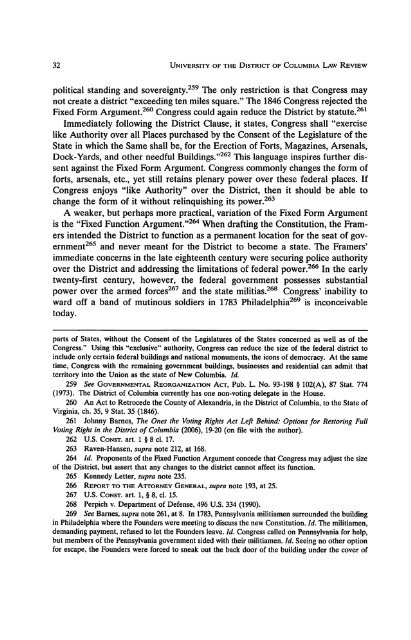Download - UDC Law Review
Download - UDC Law Review
Download - UDC Law Review
Create successful ePaper yourself
Turn your PDF publications into a flip-book with our unique Google optimized e-Paper software.
32 UNIVERSITY OF THE DISTRICf OF COLUMBIA LAW REVIEWpolitical standing and sovereignty.259 The only restriction is that Congress maynot create a district "exceeding ten miles square." The 1846 Congress rejected theFixed Form Argument. 2OO Congress could again reduce the District by statute. 261Immediately following the District Clause, it states, Congress shall "exerciselike Authority over all Places purchased by the Consent of the Legislature of theState in which the Same shall be, for the Erection of Forts, Magazines, Arsenals,Dock-Yards, and other needful Buildings.,,262 This language inspires further dissentagainst the Fixed Form Argument. Congress commonly changes the form offorts, arsenals, etc., yet still retains plenary power over these federal places. IfCongress enjoys "like Authority" over the District, then it should be able tochange the form of it without relinquishing its power. 263A weaker, but perhaps more practical, variation of the Fixed Form Argumentis the "Fixed Function Argument. ,,264 When drafting the Constitution, the Framersintended the District to function as a permanent location for the seat of government265 and never meant for the District to become a state. The Framers'immediate concerns in the late eighteenth century were securing police authorityover the District and addressing the limitations of federal power. 266 In the earlytwenty-first century, however, the federal government possesses substantialpower over the armed forces 267 and the state militias. 268 Congress' inability toward off a band of mutinous soldiers in 1783 Philadelphia 269 is inconceivabletoday.parts of States, without the Consent of the Legislatures of the States concerned as weD as of theCongress." Using this "exclusive" authority, Congress can reduce the size of the federal district toinclude only certain federal buildings and national monuments, the icons of democracy. At the sametime, Congress with the remaining government buildings, businesses and residential can admit thatterritory into the Union as the state of New Columbia. [d.259 See GOVERNMENTAL REORGANIZATION Aer, Pub. L. No. 93-198 § 102(A), 87 Stat. 774(1973). The District of Columbia currently has one non-voting delegate in the House.260 An Act to Retrocede the County of Alexandria, in the District of Columbia, to the State ofVirginia, ch. 35, 9 Stat. 35 (1846).261 Johnny Barnes, The Ones the Voting Rights Act Left Behind: Options for Restoring FullVoting Right in the District of Columbia (2006), 19-20 (on file with the author).262 U.S. CONST. art. 1 § 8 cl. 17.263 Raven-Hansen, supra note 212, at 168.264 [d. Proponents of the FlXed Function Argument concede that Congress may adjust the sizeof the District, but assert that any changes to the district cannot affect its function.265 Kennedy Letter, supra note 235.266 REPORT TO THE ATTORNEY GENERAL, supra note 193, at 25.267 U.S. CONST. art. 1, § 8, cl. 15.268 Perpich v. Department of Defense, 496 U.S. 334 (1990).269 See Barnes, supra note 261, at 8. In 1783, Pennsylvania militiamen surrounded the buildingin Philadelphia where the Founders were meeting to discuss the new Constitution. [d. The militiamen,demanding payment, refused to let the Founders leave. [d. Congress called on Pennsylvania for help,but members of the Pennsylvania government sided with their militiamen. [d. Seeing no other optionfor escape, the Founders were forced to sneak out the back door of the building under the cover of














